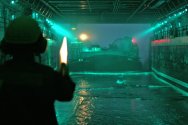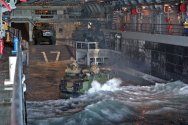Just one example, the smallest component of the USMC is the MEU, in which about 2100 marines are counted. That's before the Force Design 2030 that Berges is introducing to the USMC.Let's say an Amphibious/Medium Brigade is as follows:
440 Amphibious/Armoured Vehicles + 380 JLTV/Humvee + 500 Trucks.
For an initial wave, call it 880 vehicles in total, with the rest following 12+ hours later. You could do it with
Each MEU is divided between three battalions (excluding the CE), Ground Combat Element (GCE) which has a personnel component of 1200 marines, the other element is the Aviation Combat Element (ACE) component composed of 420 marines and finally, the last one element, the Logistics Combat Element (LCE) which totals 270 marines.
The GCE has the following vehicles:
4x M1A1
15x Assault Amphibious Vehicle(AAV) - Will be replaced by ACV
8-17x M1161 Internally Transportable Vehicles (ITV)
31x Medium Tactical Vehicles
7-17x Light Armored Vehicle (LAV) - Will be replaced by ARV
105x HMMWV - Will be replaced by JLTV
The ACE has the following aerial elements:
3x UH-1Y Huey
2x KC-130J
4x AH-1Z
5x RQ-21A Small Tactical Unmanned Air System (STUAS)
6x Harrier (AV-8B) - Will be replaced by F-35B
The LCE has the following vehicles:
15 MTVR - Will be replaced by LVSR
18 HMMWVs - Will be replaced by JLTV
2 wreckers
2 bulldozers
3 forklifts
4 bulk fuel trucks
2 water trucks
1 tank retriever
1 AAV recovery
The MEU which is the smallest organization of the MAGTF structure that has a total of 2100 marines has about 240 amphibious/armored vehicles.
Today, the USMC cannot transport an entire MEF by sea, unless it brings together all the landing ships of other ARGs available to be employed under a single MEF, the III MEF in Japan/Okinawa which is the smallest of the others. two MEFs could be transported by sea if this described situation occurred.
If you really believe that just one anti-ship missile is enough to neutralize a Type 071/Type 075, you are certainly unaware of the anti-missile capability of PLAN ships.Option 1. 49x Type-072A LST. 18 vehicles each. $637 Million Ship Cost
Option 2. 15x Type-071 LPD. 60 vehicles each. $3000 Million Ship Cost
Option 3. 22x Type-075 LHD. 40 vehicles each. $22000 Million Ship Cost
So you can see that the LST option is by far the lowest cost option and because there are so many of them, you can afford to take losses. In comparison, there are a lot fewer Type-071 and Type-075s, and it still only takes 1 antiship missile to take any of these ships out.
In fact, you could buy 49x LSTs plus 4x Type-052D Air-Defence destroyers and it would still be the lowest cost option.
I already reported this capability in a previous post on this same topic, I don't see the need to repeat it, but pay attention, I'm not questioning the value of LSTs in an Op Amp, you're making a comparison that doesn't make sense.
An LST cannot reach the beach without first having complete coastal superiority, and this is achieved through LPD, LSD, LHD and LHAs, without complete coastal superiority, an LST would be easily neutralized and sunk that has only minimal point defenses such as cannons anti-aircraft.
Therefore, as a first wave attack, an LST is not capable of landing on the beach, it will always act in the rear of an amphibious force that will make the initial attack and the landing on the initial beach, conquering the position in the field of operations, that if can only with the large ships like LPD, LSD, LHD and LHAs, not with LSTs.


